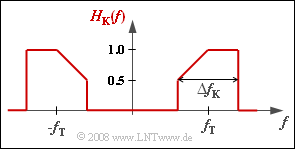Exercise 1.10: BPSK Baseband Model
In this exercise, we consider a BPSK system with coherent demodulation, i.e.
- s(t) = z(t)⋅q(t),
- b(t) = 2⋅z(t)⋅r(t).
The designations chosen here are based on the "block diagram" in the theory section.
The influence of a channel frequency response HK(f) can be taken into account in a simple way if it is described together with modulator and demodulator by a common baseband frequency response:
- HMKD(f)=1/2⋅[HK(f−fT)+HK(f+fT)].
- Thus the modulator and demodulator are virtually shortened against each other, and
- the band-pass channel HK(f) is transformed into the low-pass range.
The resulting transmission function HMKD(f) should not be confused with the low-pass transmission function HK,TP(f) as described in the chapter "Equivalent Low-Pass Signal and its Spectral Function" of the book "Signal Representation", which results from HK(f) by truncating the components at negative frequencies as well as a frequency shift by the carrier frequency fT to the left.
For frequency responses, in contrast to spectral functions, the doubling of the components at positive frequencies must be omitted.
Notes:
- The exercise belongs to the chapter "Linear Digital Modulation - Coherent Demodulation".
- Reference is made in particular to the section "Baseband model for ASK and BPSK".
- The subscript "MKD" stands for "modulator – channel – demodulator" German: "Modulator – Kanal – Demodulator").
Questions
Solution
- HK,TP(f) results from HK(f) by cutting off the negative frequency components and shifting fT to the left.
- For frequency responses – in contrast to spectra – the doubling of the components at positive frequencies is omitted. Therefore:
- HK,TP(f=0)=HK(f=fT)=1.
- Because of the real and asymmetrical spectral functions HK,TP(f), the corresponding time function (inverse Fourier transform) hK,TP(t) is complex according to the "Allocation Theorem".
(2) Here only the third proposed solution is correct:
- The spectral function HMKD(f) always has an even real part and no imaginary part. Consequently hMKD(t) is always real.
- If HK(f) had additionally an imaginary part odd by f=fT, HMKD(f) would have an imaginary part odd by f=0. Thus hMKD(t) would still be a real function.
The diagram illustrates the differences between HK,TP(f) and HMKD(f). The parts of HMKD(f) in the range around ±2fT need not be considered further.
(3) HMKD(f) is additively composed of a rectangle and a triangle, each with width ΔfK and height 0.5. It follows:
- hMKD(t)=ΔfK2⋅sinc(ΔfK⋅t)+ΔfK4⋅sinc2(ΔfK2⋅t)
- ⇒hMKD(t=0)=ΔfK2+ΔfK4=0.75⋅ΔfK⇒hMKD(t=0)/ΔfK=0.75_.
(4) The second proposed solution is correct:
- The first sinc–function does have equidistant zero crossings at the distance 1/ΔfK.
- But the equidistant zero crossings of the whole time function hMKD(t) are determined by the second term:
- hMKD(t=1ΔfK)= ΔfK2⋅sinc(1)+ΔfK4⋅sinc2(0.5)=ΔfK4,
- hMKD(t=2ΔfK)= ΔfK2⋅sinc(2)+ΔfK4⋅sinc2(1)=0.

